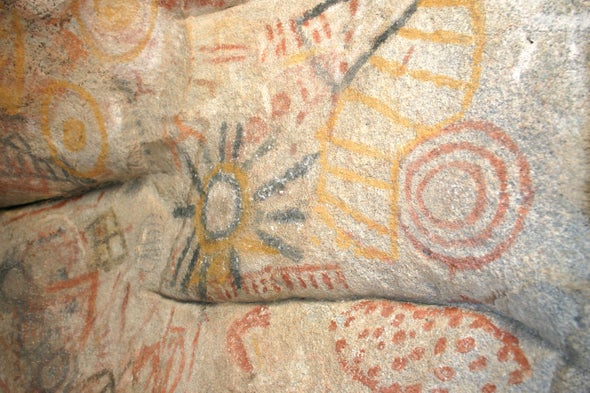(单词翻译:单击)
听力文本
This is Scientific American's 60-second Science, I'm Emily Schwing.
Sometimes discoveries seem so simple.
"You know, basically, we found a bunch of holes in the ground."
That's Eduard Reinhardt. He's an archaeologist and geologist at McMaster University in Ontario, Canada.
"But, you know, ultimately, very important holes in the ground."
Reinhardt and colleagues believe they've found some of the first clear evidence of mining activity in a system of caves in Quintana Roo on the Yucatán Peninsula. The find dates back to between 10 and 12,000 years ago.
"So these are some of the very early people that have come and migrated to the Americas via the Bering Strait."
But getting to what remains of these miners and the tools they left is a challenge.
"Like, as cave divers, you gotta be so careful you don't get lost."
These cave systems in Mexico, which were once dry, are now completely filled with water, thanks to a warming climate and sea levels that rose over time. Winding passageways are narrow and dark. And the walls are made of unforgiving limestone, porous and with sharp edges. Reinhardt says the water that filled the caves has preserved everything.
"It's basically almost like somebody working at a factory: they turned the lights off, they went away and nobody ever came back."

When divers started telling Reinhardt about what they were seeing inside the cave, he decided to go for a dive himself. He found concentrations of charcoal—meaning that the people who walked here thousands of years ago probably used fire to light their way. And there are stone cairns, which Reinhardt believes the people built as navigation markers. Reinhardt also says lots of tools remain. And they were made from the stalagmites that hung from the cave ceiling.
"They were breaking off and then using as hammers. So you can see the percussion marks where they were banging up, breaking up the stone on the bottom."
The discovery is in the journal Science Advances.
So what were these ancient people mining and prospecting for?
"There was a little bit of sediment still on the wall of the pit. So I grabbed a vial, my sample vial, and grabbed some of this sediment. And underwater, the red light gets attenuated, so it looked kind of brown. And I was thinking, Well, maybe it's ocher. You know, I was thinking about that, but it's like, Well, it looks kind of cruddy, I don't think that's what it is. But then I got out of the cave and into the sunlight, and it was just like this spectacular bright, bright red. So then I knew that that's what they were after."
Ocher—it's among the earliest known pigments employed by humans. And it's got many uses: for sunscreen, to preserve animal skins, in burials and ceremonies. And people still use it, even today, in artwork.
"Yeah, I mean, it was, you know, it's a prominent and used geomaterial, if you will, throughout the time period. And dates to usage for thousands of years prior to Paleo-Indians around the world."
Thanks for listening for Scientific American's 60-second Science. I'm Emily Schwing.
参考译文
这里是科学美国人——60秒科学系列,我是埃米莉·施温。
有时,发现似乎很简单。
“基本上来说,我们发现了一大堆地下洞穴。”
这是爱德华·莱因哈特所说。他是加拿大安大略省麦克马斯特大学的考古学家和地质学家。
“但归根结底,都是非常重要的地下洞穴。”
莱因哈特和同事认为,他们首次发现了清晰的证据,证明尤卡坦半岛昆塔纳罗州的洞穴系统中有开矿活动。这个发现可以追溯到10到1.2万年前。
“因此,这些是很早就通过白令海峡来到美洲并迁移至此的人。”
但要找到这些矿工的遗骸和他们留下的工具是项挑战。
“比如,作为洞穴潜水员,你要非常小心,避免迷路。”
墨西哥的这些洞穴系统曾经非常干燥,但由于日益增温的气候和随时间上升的海平面,这些系统现在已完全被水充满。蜿蜒曲折的通道狭窄又黑暗。石灰岩筑成的墙壁很难对付,气孔众多,而且边缘锋利。莱因哈特表示,填满洞穴的水保存了一切。
“这基本上就像在工厂工作的人:他们关了灯,离开工厂,再也没有人回来过。”
当潜水员开始和莱因哈特讲他们在洞穴中看到的东西,他决定自己亲自下水去看看。他发现木炭浓度很高,这意味着几千年前在这里行走的人可能用火来照亮他们的道路。那里还有堆石标,莱因哈特认为人们建造堆石标当作指南标志。莱因哈特还表示,那里还保留了大量工具。这些工具由悬挂在洞顶上的石笋做成。
“他们折断石笋后当锤子用。因此,你可以看到敲打的痕迹,就在锤子碰撞并砸碎下面石头的地方。”
这一发现发表在《科学进步》期刊上。
那这些古代人在开采和勘探什么呢?
“矿井墙上依旧有少量沉积物。所以我拿了个小瓶,这是我的样品瓶,然后采集了一些沉积物。红光在水下会变暗,所以看起来有点像棕色。我当时想,这可能是赭石。我当时还在想,这东西虽然看起来有点粗糙,但我不认为这是它本来的样子。但之后我走出洞穴来到阳光下,我发现它呈现出壮观的鲜红色。那时我知道它是什么了。”
那就是赭石,是人类使用的已知最早的颜料之一。它有很多用途:可以制造防晒霜,保存兽皮,用于葬礼和庆典。人们现在甚至将其应用于艺术品。
“是的,可以说赭石是非常杰出的、整个人类时期都在使用的岩土材料。其应用时间能追溯到古印第安人之前数千年。”
谢谢大家收听科学美国人——60秒科学。我是埃米莉·施温。
译文为可可英语翻译,未经授权请勿转载!
重点讲解
重点讲解:
1. thanks to 幸亏;归因于;
They were already under stress, thanks to the aftershock of last year's drought.
去年遭受的旱灾让他们心有余悸、倍感忧虑。
2. be made of (由…)构成的;(由…)制成的;
The gates were made of wrought iron.
这些大门是用熟铁制成的。
3. turn off 关上;关掉;截断,切断(…的供应);
The light's a bit too harsh. You can turn it off.
灯光有点太刺眼了。你可以把灯关掉。
4. break off 折断;(使)断开;
The two wings of the aircraft broke off on impact.
飞机的两个机翼遭受撞击折断了。
关注微信公众号【可可双语精读】,获取详细讲解内容


